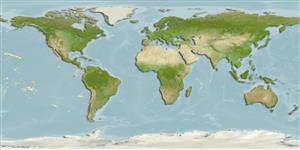Classification / Names
Common names | Synonyms | Catalog of Fishes (gen., sp.) | ITIS | CoL | WoRMS | Cloffa
Actinopterygii (ray-finned fishes) >
Ophidiiformes (Cusk eels) >
Ophidiidae (Cusk-eels) > Neobythitinae
Etymology: Luciobrotula: Latin, lucius = pike + Latin, brotula, -ae = little, bud, shoot (Ref. 45335); coheni: Named for Daniel M. Cohen, Bodega Bay, California.. More on author: Nielsen.
Environment / Climate / Range
Ecology
Marine; benthopelagic; depth range 450 - 790 m (Ref. 83453), usually 605 - 790 m (Ref. 83453). Deep-water, preferred ?
Eastern Pacific: Panama and Peru.
Size / Weight / Age
Maturity: Lm ? range ? - ? cm
Max length : 45.5 cm SL male/unsexed; (Ref. 83453)
Short description
Morphology | Morphometrics
Dorsal
soft rays
(total): 81-89;
Anal
soft rays: 59 - 65;
Vertebrae: 53 - 54. This species is distinguished by the following set of characters: lateral line ends below dorsal fin rays 28-37; dorsal fin rays 81-89, anal fin rays 59-65, precaudal vertebrae 15; total number of rakers 21-26 (3 long and 18-23 plates); longest gill raker 1.8-3.1% SL; snout to end of lateral line 60-71% SL; one interorbital pore 1 and occipital pores 4 (Ref. 83453).
Life cycle and mating behavior
Maturity | Reproduction | Spawning | Eggs | Fecundity | Larvae
Nielsen, J.G., 2009. A revision of the bathyal genus Luciobrotula (Teleostei, Ophidiidae) with two new species. Galathea Report 22:141-156. (Ref. 83453)
IUCN Red List Status (Ref. 115185)
CITES (Ref. 94142)
Not Evaluated
Threat to humans
Harmless
Human uses
More information
Common namesSynonymsMetabolismPredatorsEcotoxicologyReproductionMaturitySpawningFecundityEggsEgg development
Age/SizeGrowthLength-weightLength-lengthLength-frequenciesMorphometricsMorphologyLarvaeLarval dynamicsRecruitmentAbundance
ReferencesAquacultureAquaculture profileStrainsGeneticsAllele frequenciesHeritabilityDiseasesProcessingMass conversion
Tools
Special reports
Download XML
Internet sources
Estimates of some properties based on models
Phylogenetic diversity index (Ref.
82805): PD
50 = 0.5156 [Uniqueness, from 0.5 = low to 2.0 = high].
Bayesian length-weight: a=0.00407 (0.00156 - 0.01061), b=3.12 (2.90 - 3.34), in cm Total Length, based on LWR estimates for this (Sub)family-body shape (Ref.
93245).
Trophic Level (Ref.
69278): 3.7 ±0.6 se; Based on size and trophs of closest relatives
Resilience (Ref.
69278): Medium, minimum population doubling time 1.4 - 4.4 years (Preliminary K or Fecundity.).
Vulnerability (Ref.
59153): Moderate to high vulnerability (47 of 100) .
